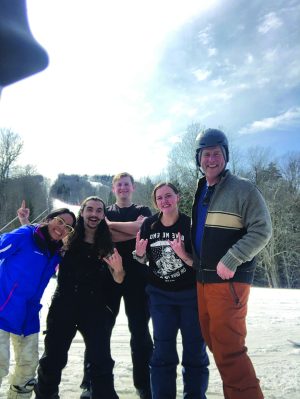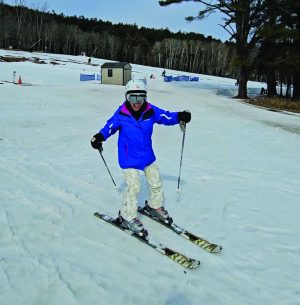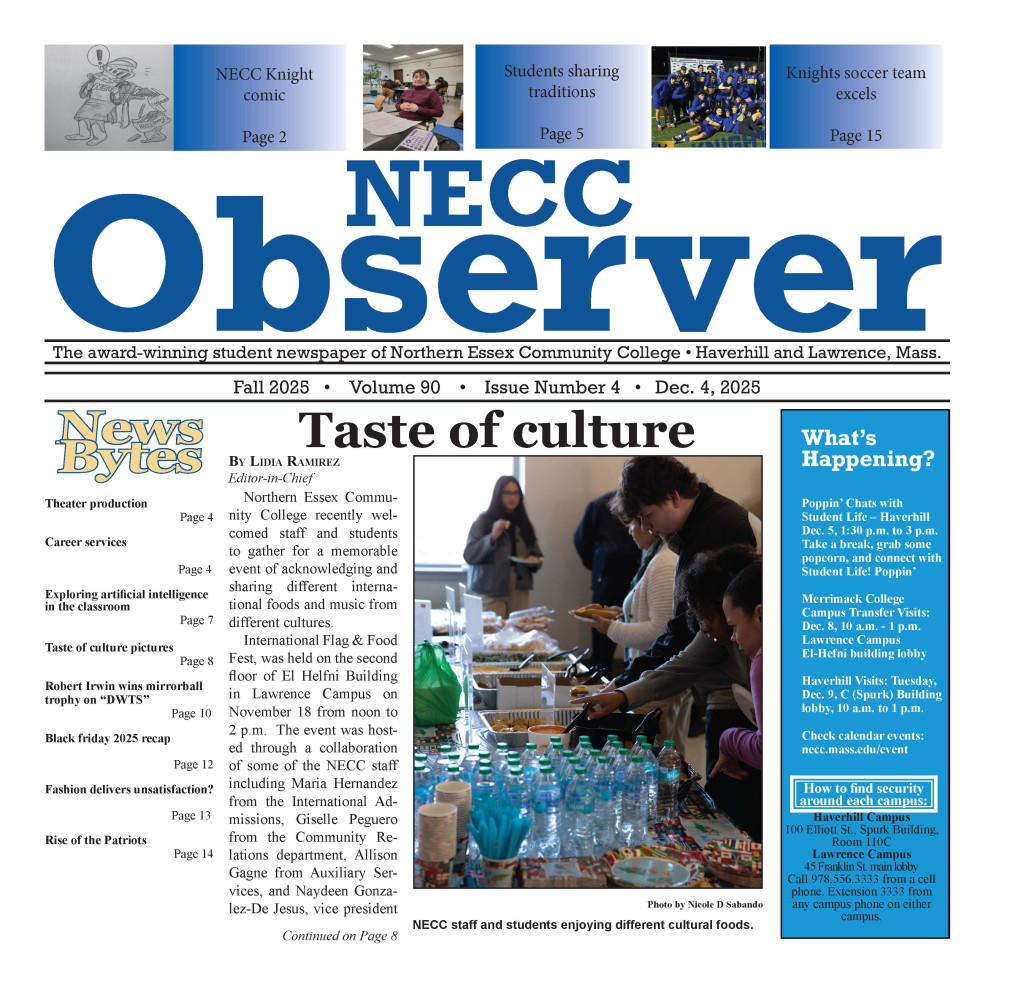
Students Lauren Rafferty, this reporter Daniela Valdivia-Terres and alum Chris Drew had fun during the Ski Trip which was organized and lead by Engineering Professor Doug Leaffer. About 1.5 hours away from NECC Haverhill campus, Mount Sunapee in Newbury in western New Hampshire was the chosen place to spend a full day trip in contact with nature March 13.
Rafferty, NECC student of mechanical engineering, said she started snowboarding when she was 10 years old and since then, she has not stopped.
She descended smoothly the snow mountain, like riding a kind of levitating carpet and landed with a graceful 360º spinning in front of my camera. Not wanting to show off, she just went downhill with great confidence and wide experience. Indeed, she said she took private and group lessons when younger for about six years and spent time with her family in North Conway, a touristic winter spot in north New Hampshire where she used to practice snowboarding.
Rafferty, now 26, said her dad took her skiing a couple of times when she was 5 years old, but she did not like it. After she learned how to snowboard, she tried skiing again but after the first ride she was convinced snowboarding is “her thing.”
By contrast “my thing” is enjoying the beach. I was born in Callao, a port in Lima, Perú. The lowest coastal weather in winter is about 65 ºF and the highest in summer is around 90 ºF.
Sometimes in winter, it drizzles so the feeling goes down to 55 ºF and we dress warm wearing heavy winter jackets, but the good news is that winter is not that long. Summer is from mid-December to mid-March, but I used to go to the beach as soon as it got warm in November until late April. I grew up swimming and playing with the waves and enjoying the ocean breeze, along with a book when taking a break on the shore.

When I moved to New England, the shortage of natural daylight crushed me. The harsh freezing cold made me feel that there was no more option just to truly hibernate like a hedgehog. It made me feel isolated, homesick, and blue. The doctor diagnosed me with seasonal affective disorder. Vitamin D was prescribed; however, I knew as Latina, I only needed “vitamin Sea.”
When I saw the Ski Trip flyer on campus, I decided to give myself a chance to experience the snow in an unusual way. What is “the thing” about going up to the mountains to feel even colder and wearing heavy gear to throw oneself down from the top of the hill? With skepticism I asked if someone who knows nothing about skiing could go. Leaffer told me “No problem,” so I signed up.
Dressed in Peruvian baby alpaca wool vest, merino sheep wool socks, three layers of 100% Peruvian Pima cotton t-shirts, a – 50 ºF snow pants, and a double layer – 50 ºF winter jacket, looking like I was going to climb the Everest, I dared to face the snow mountain.
When facing the snow mountain with her snowboard, Rafferty assured me there is a sense of freedom. “I can put my headphones on, don’t have to hear people just see them… just be able to go fast. And even if I fall, I know it’s not that bad, so I take the risk, but try not to fall.”
“It’s hard the first few times you do it but as soon as you get that one run you don’t fall at all, you wanna do it again!” emphasized Rafferty.
The base elevation of Mount Sunapee is 1,233 feet and the highest elevation is 2,743 feet. Rafferty, Drew and Leaffer took the lift to the top and went downhill one right after the other one. I was video recording and admiring their confidence in riding down the snow mountain. So fearless, I thought.
Drew, an NECC alumni who graduated in 2023, majored in chemistry, physics, and environmental science, and currently he is a peer tutor at NECC. Drew said he tried snowboarding when he was 13 years old but then stopped. Years later, he went back to it, and he loved it. In contrast to Rafferty, Drew said he likes the social aspect of it. He likes to ride downhill with his friends and enjoys seeing his friends doing something funny or a trick, race them down the mountain, and take the lift to the top again talking together. “The whole vibe of it is a lot of fun,” he said.
With a sunny 55 °F, Drew got 37 miles per hour, beating for a few miles Rafferty’s speed. Drew’s forte is speed. He recommends staying straight and not to move to much if going too fast. He sees Mount Sunapee as a good place to enjoy skiing or snowboarding, and even the advanced terrains “are not unbearable.”
Falling is part of the learning process. Drew is fully convinced about it, he stated “I learn best from my mistakes, the more I fell the more I say ‘all right I’m not going to do that.’”
However, when I was trying to go down the “Bunny Hill,” a slope with a teeny-tiny elevation, a couple of inches tall, I was petrified.
Standing up on my boots attached to the skies, I felt like I was standing on soap. It was so slippery that I thought I would crash against the pine trees at the end of the slope two miles away. Just before to step on the belt that would take me up to the top of the minuscule hill, Leaffer told me two instructions, “do pizza” which means making a triangle with the skies, putting the top front together and opening the heels back; and “do French fries” which means set the skies parallel straight. Still, his food instructions reminded me of my animadversion to cook and did not help me to move forward. The senior man at the end of the belt saw me in desperation, he walked to me and gently explained how I could stop and encourage me to try. I breathed in and out and I tried. Leaffer waited for me down the slope just in case I needed a hand.
I went downhill screaming so loud that I could cause an avalanche and just moved a couple of feet and I fell. So, Leaffer took the belt up the hill to meet me and helped me go down the slope and strongly suggested I take a professional lesson. So, I did.
A snow-avid friend of mine lent me her equipment: gloves, face polar fleece, helmet, snow googles, skies, skies boots, and poles. However, my right calf got bruised as the boot was too tight, so I had to rent boots and therefore, the skies ($59).
After paying for a one-hour private lesson ($159), the assigned instructor helped me to find the right size of boots. I learned that it is not only about the shoe size but the comfort and size of the calves are important.
Once the boots were appropriate, a ski specialist sized my height and asked for my weight, then he gave me shorter skies than the ones from my friend, saying, “as a beginner, you need skies that are not taller than your chin height and the boots elevation need to be adjusted according to your weight.” That was the “ah-ha” moment.
Back on the snow, the instructor was outstanding. He was patient, funny, and cheerful. I fell a couple of times, but he was taking every opportunity to teach me something, even how to fall avoiding major harm. By the end of the lesson, I conquered my fears. I asked for “permission” to the mountain, and for a few nano seconds, like Rafferty said, I enjoyed “freedom” and I felt like I flew. What a joy!
I encountered a sense of liberty but from my prejudice, fear, and stress. Thinking that because I was not born nor grown up with it, I would not get it and that there was a reason no Spanish-speaking people were up there in the mountain, or thinking that I would break my leg, therefore I would not be able to take care of my young child, and an array of other contradictions were left behind once I briefly did ski.
Tips to not perishing in the attempt
Rafferty’s tips: spread the butter with your board, go slow until you are ready, always wear a helmet, always! And (the most importantly for her) “always wear your Crocs” so after taking your snow boots off it will be easy to walk around or go back to your car. She carried her Crocs in a light backpack.
Drew seconded Rafferty on “always wear a helmet” and added “have fun, practice getting on and off the chair before going to a big mountain. If you fall it’s a little scattering collect yourself and trying to get off and if the person [the lift operator] is not paying attention it can be a nightmare!”
With a smile on his face, Leaffer shared his top-tip for beginners: “start young!” Then, for kids/parent, he suggested renting equipment until they stop growing. In general, he suggested taking one or two lessons.
“When you are on a very steep mountain looking down, don’t look to the bottom of the mountain when you are skiing. Only think about the patch of snow directly in front of you. If you only focus on the patch of snow directly in front of you, it won’t be as intimidating and before you know it, you will be down the mountain,” recommended Leaffer.
From my end, my suggestion is that it is never too late to try something new. Hence, here I am studying in my mid-40s. Take some lessons from instructors who work “in situ” as they know very well the slopes. Save money; it is true it is not cheap but it worth it.
For the first time, I enjoyed being outdoors in winter. The view up in the snow mountain is beautiful, the reflection of the sunny sky on the snow is blindingly resplendent. Skiing can be challenging but as my peers said “falling is part of the process” and “once you get it, you’ll want to do it again.” For me, my big lesson from the mountain was being resilient and trusting more in myself.
Thanks to NECC and Professor Leaffer for making it possible. Hopefully next year, more students will join the “vibe” of skiing. I definitely will.

